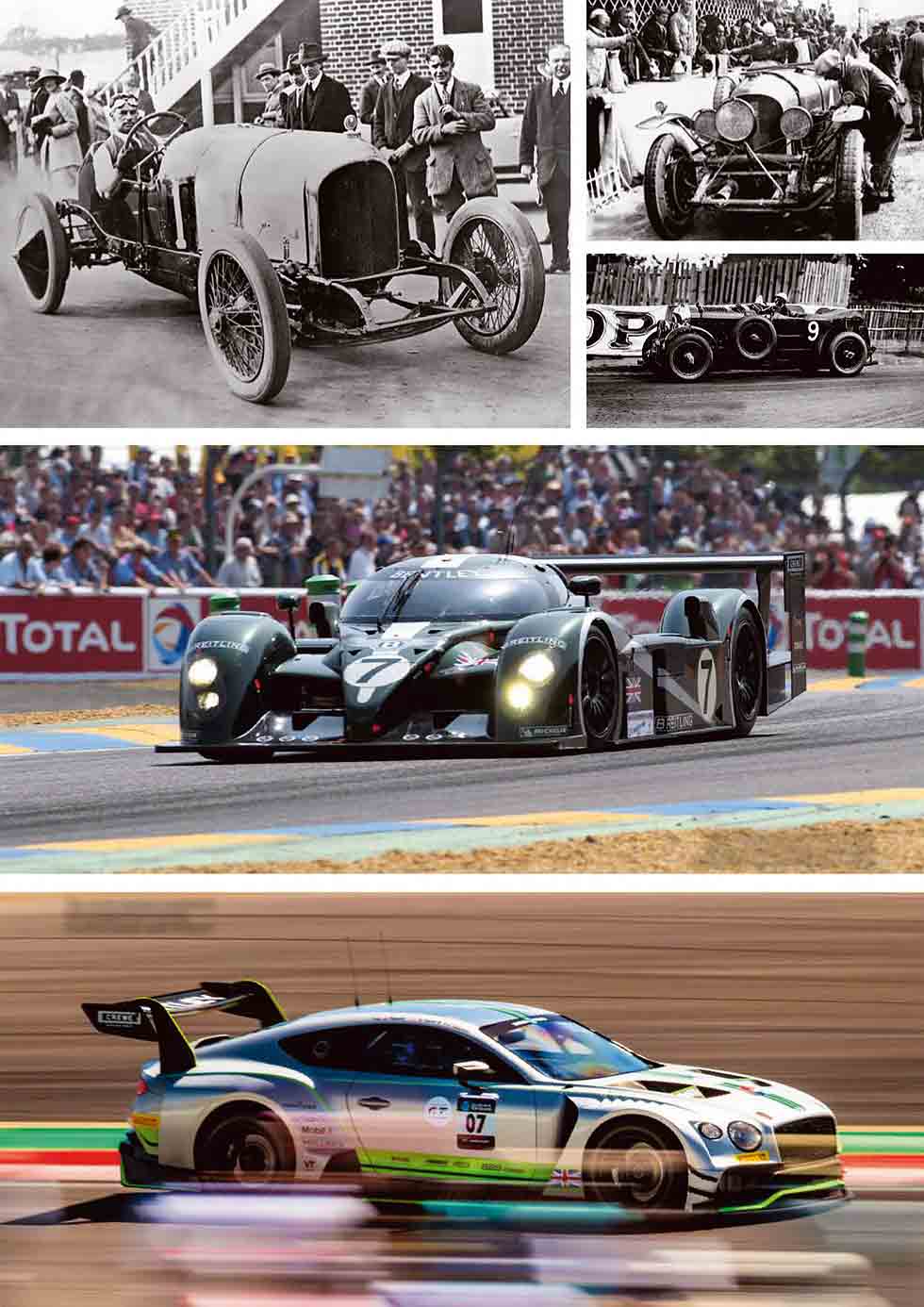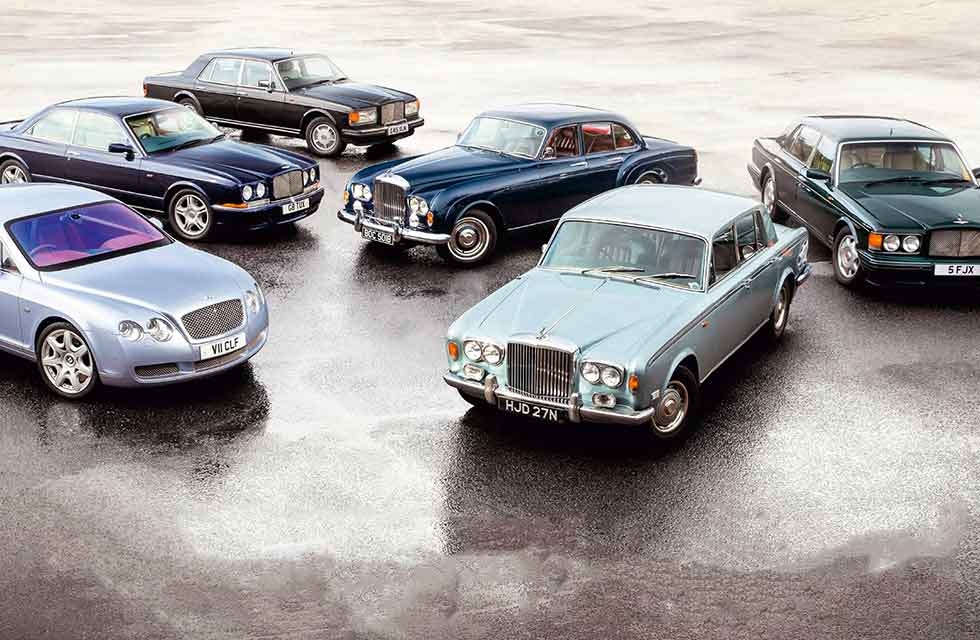
£8-200k power and luxury tipped. Plus Dirk van Braeckel on designing the Conti GT. Bentleys to buy now Immense power, luxury and, yes, great value – the six Bentleys you should buy now. ‘Directly ahead of you is a wonderful timber dashboard framed in marquetry and stocked with Smiths dials’ Bentleys to Buy Now The world’s greatest luxury cars are ripe for buying now – here’s how to pick a Bentley Flying Spur, T1, Eight, Turbo R, Continental R or Continental GT for as little as £8000. Plus The marque’s racing pedigree, and Conti GT designer Dirk Van Braeckel talking timeless style. Fancy a new set of wings? We drive the six Bentleys that are the best value examples of the marque in 2019. Words: Andrew Noakes. Photography: Charlie Mage.
From left to right: Continental GT, Continental R, Eight, S3 Flying Spur, T1 and Turbo R
Are we completely mad? Here we are rounding up the best value Bentleys of the moment and in amongst cars costing £10,000 or so there’s an interloper which you could see for sale on the high side of £200k. But this is one of those times when it’s important to separate cost from value, and look not just at today’s prices but also at the potential for this car – and its five stablemates – to rise in value in the years to come.

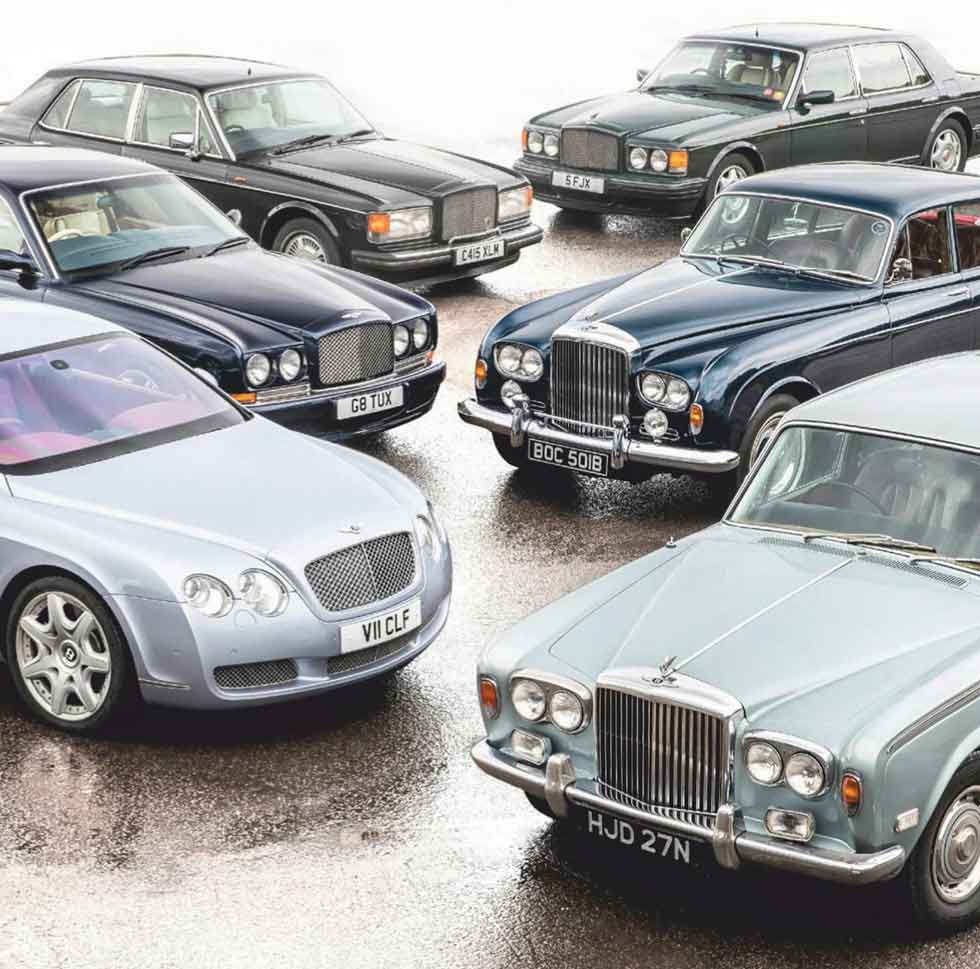
Bentley S3 Continental Flying Spur
The Bentley S3 Continental Flying Spur is the oldest as well as the most expensive of these cars, its early Sixties vintage underlined by the chrome bumpers and the controlled curves of the aluminium Mulliner Park Ward body. Swing open the door using the wonderfully curvaceous handle and you’re in a cabin exuding old-world charm even though this car dates from 1964, the same year that NASA’s Gemini spacecraft made its first flight.
You sit in a simple, hide-faced seat with an evocative view out over the curves of the wings and bonnet to the ‘flying B’ mascot on top of the radiator grille. Directly ahead of you is a wonderful timber dashboard framed in hand-made, honey-coloured marquetry and stocked with half a dozen Smiths dials, each one carrying white numerals and a Bentley ‘B’ on its black face. The big 140mph speedo and matching rev-counter – with red paint from 4500rpm to 5000rpm – are both upside-down to bring the most critical ranges of their operation into easy view between the narrow rim and three spokes of the huge Bakelite steering wheel.
The transmission selector lever sprouts from the right-hand side of the steering column and controls a four-speed General Motors Hydramatic transmission, built at Crewe under licence. It’s coupled by a simple fluid flywheel to a 6.2-litre pushrod V8, a mild update of the all-alloy L-series engine introduced in 1959 in the Rolls-Royce Silver Cloud II and Phantom V, and the Bentley S2. For the S3 the engine gained bigger carburettors and a higher compression ratio, reflecting the wider availability of higher-octane fuel. From inside the engine is virtually silent, even when you push the accelerator down through its long, long travel to explore the top end of the rev range at a heady 4500rpm. There’s little need to do that, though, because the engine provides plenty of mid-range urge. The gearbox can be left to its own devices and you’re rarely aware of it, save for the lumpy change from second to third that is often characteristic of these transmissions, though the word is that it can be tuned out with careful set-up.
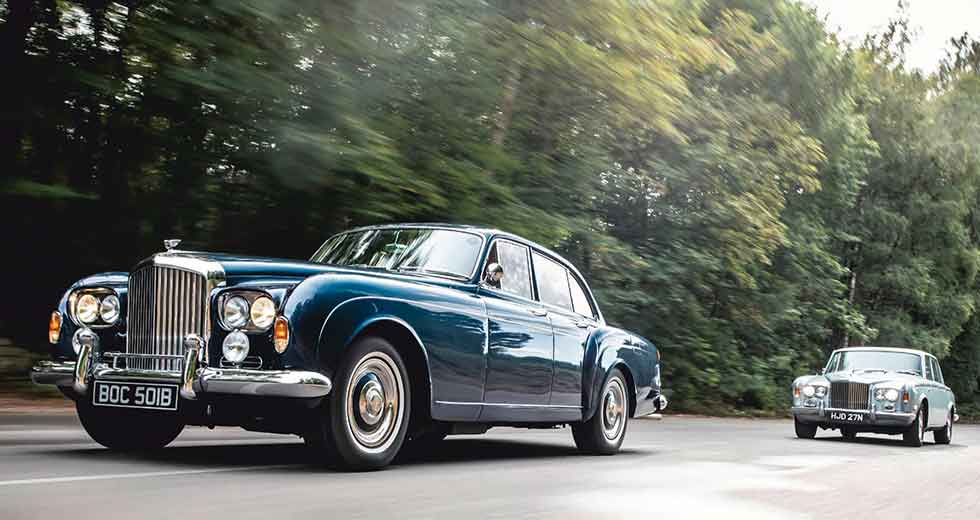
The steering column disappears down through the floor and the throttle and brake pedals both sit to the right of it, so there’s little chance of left-foot braking. There’s some useful feedback through the steering wheel, but the rim is as slippery as a Teflon-coated eel. The Spur is too big and rolls too much to be entirely happy on country roads, and it’s much more at home eating up the miles on motorway or autoroute, where its superb directional stability gives it a feeling of unflappable sureness.
You would have needed unflappable sureness in your financial affairs back in ’1964 to be able to afford one too. The basic price was £7862, the same as the two-door Continental, when a Ferrari 275GTB Berlinetta or Maserati Quattroporte could be yours with change for £6000. The alloy-bodied Continentals were a whopping £2497 more than Bentley’s standard steel S3 saloon, a difference that would have bought a new Porsche 356 cabrio. Most of the 311 S3 Continentals built were two-door cars, with only 88 four-door Flying Spurs emerging from the Park Ward works in Willesden. Yet today it’s the two-door cars which are worth more – up to twice as much – and that’s what makes the Spur a relative bargain. Project cars can be found for under £100,000 while the best can top £200,000. Expert appraisal is essential, as the costs of restoration are high – budget £10,000 or more for an engine rebuild, for instance, though on the plus side Bentley can still supply parts for these cars from its vast Orion Park facility. Engines and gearboxes are generally trouble free even at high mileages, but the all-drum brakes need careful set-up and it’s important to check for rot in the chassis and sills under the alloy skin, which is more dent-prone than steel. Otherwise these are robust and reliable cars.
‘On motorway or autoroute the Spur’s superb directional stability gives it a feeling of unflappable sureness’
Owning an S3 Continental Flying Spur
‘I’ve owned this car for four years,’ says Chris Rigby of his S3 Continental Flying Spur. ‘It’s a shape that I’ve always admired – for me it was the pinnacle of this age of motoring. I couldn’t afford the two-door version so I ended up with this four-door, but because I’ve got two young daughters it’s worked out quite nicely. In the summer I use it weekly, for the odd show and we always do the Concours of Elegance.
These cars are very reliable and they’re the culmination of the S-series; by then they’d got everything right. The first big expense was a rebuild of the engine – that happened about a year and half ago. You’re still able to phone up Crewe and get parts for the engine – an original camshaft, for example. This year I did the brakes; the suspension is OK and the bodywork is in good shape. I haven’t had to do much maintenance because it’s been done as part of the restoration – really all I do is top up the oil and polish it.’
TECHNICAL DATA FILE SPECIFICATIONS Bentley S3 Flying Spur
Engine 6230cc V8, 16-valve, two SU HD8 carburettors
Max Power 180bhp @ 4000rpm approx
Max Torque; 225lb ft @ 2000rpm approx
Transmission Four-speed automatic, rear-wheel drive
Suspension Front: independent, wishbones, coil springs, anti-roll bar. Rear: live axle, radius arms, leaf springs
Steering Cam and roller, power assisted
Brakes Disc front, drum rear, servo-assisted
Weight 2000kg approx (4410lb)
Performance Top speed: 118mph;
0-60mph: 10.8sec CC
Price Guide £75,000-£175,000

Bentley T1
The Bentley T1 that replaced the S-series in 1965 was a very different machine. Alongside its stablemate, the Rolls-Royce Silver Shadow, this was Crewe’s first monocoque car and the new structural architecture delivered more efficient packaging, with more interior space than before despite smaller external dimensions. The T-series was more comfortable, too, thanks to independent rear suspension with self-levelling using Citroën hydraulics. The difference is immediately apparent on the road – the T1 floats over bumps and ridges that would have the Flying Spur’s live axle bouncing and fidgeting. But there’s still plenty of roll, and the big two-spoke wheel with its finger-light response has virtually no feedback to give you any clues that the front tyres are approaching their limit – until they start howling in protest. Better to take it easy in the corners, then, and use the straight bits to exploit the smoothness and torque of the engine.
The L-series V8 under the T1’s vast bonnet was stroked in 1970 to provide an extra half-litre of capacity, and with the new engine came a three-speed automatic transmission and a torque converter. The selector is still column-mounted and has a pointer moving in a quadrant on top of the column to show which mode is selected – the usual P, R, N and D positions, supplemented by I (intermediate) and L (low). The combination of the larger engine and revised driveline makes progress effortless, and stopping is easy too, thanks to big discs and high-pressure hydraulic power. Comfort is enhanced by bigger seats that now have electric adjustment, and a driving position that could have been modelled on the most cossetting of gentleman’s club armchairs. The dashboard is still faced in veneer like in the S3, but the handcrafted inlays have gone and instead there’s a leather-clad crash pad framing the walnut panel. The rev-counter has disappeared, too, leaving a 140mph speedo plus fuel gauge, ammeter and clock, the meagre array of instruments signalling that the sporting demeanour of the Bentley brand had by this stage almost completely disappeared.

In truth there was little to persuade buyers to choose the T1 rather than the Shadow, besides a paltry £50 price advantage. Far more of Crewe’s customers preferred the gothic splendour of the Rolls-Royce radiator grille and Spirit of Ecstasy, together with the quality and luxury that it implied, than opted for the rounded Bentley radiator grille and the curvaceous bonnet that matched it. Only 1703 four-door saloons were made up to 1977, plus nine long-wheelbase saloons. There were also 114 two-door saloons and 41 convertibles built by Mulliner Park Ward and James Young, and a solitary Pininfarina-bodied coupé. That’s 1868 Bentleys in 13 years, a total dwarfed by Shadow production of more than 20,000.
The engines are lightly-stressed and can achieve high mileages, so be suspicious of any car showing signs of engine wear. A full rebuild involves removing the cylinder liners, and could cost more than the car is worth. Ancillaries like alternators are expensive too, so check that everything works. Look for leaks in the brake and suspension hydraulics. A refresh of the system is wise after 60,000 miles, and will cost £2000. Knocking noises from the front can indicate worn ball joints, which are expensive to fix.
Rust is an issue, and good repairs are costly. Check the sills and wheelarches for bubbling paint or evidence of previous repairs, and check the rear spring cups which can collect water and rust out. The door skins, bonnet and bootlid are aluminium alloy, so check for dents and signs of galvanic corrosion where the alloy meets steel. Interiors are easy to dismantle and rebuild, but not cheap – even a refresh could cost more than £2000. Heating and aircon faults can also be expensive to fix. There are enough T1s around that you can afford to walk away from cars needing a lot of work and wait for a better example, but if you do want a project car you can pay well under £5000 for a four-door saloon. Good cars start around £10,000, with the very best four-doors up to double that. The rarer two-door saloons and dropheads can reach £40,000. Even though the T1 now commands a small premium over R-R Silver Shadows or the later Corniches, it’s still a bargain.
Owning a Bentley T1
Says T1 owner Nick Hine, ‘My late father had a ‘1973 Shadow, so it’s a sort of a reminiscence and family tie-in. My 81-year-old mum loves it and I used it last summer as my niece’s wedding car. The Silver Mink is a lovely colour, close to the shade my father had, and it’s a great combination with the Oxblood interior. I share it with my daughter, Rosabella. We bought it together as our first entry into the Bentley market and as a future classic and investment. We knew that it needed a bit of work, but it was a slight leap into the unknown. It wasn’t in too bad shape, but it had been dry-stored for a while so needed work on the brakes and the suspension, which are really quite complex. It’s a lovely car to drive and stops in a straight line, whereas before it was a bit juddery. There’s a brilliant specialist network and we are very fortunate to have a great Bentley specialist just around the corner. I love the shape, it’s got beautiful curves, and it’s superbly comfortable.’
TECHNICAL DATA FILE SPECIFICATIONS Bentley T1
Engine 6750cc V8, 16-valve, two SU HD8 carburettors
Max Power 200bhp @ 4000rpm approx;
Max Torque 250lb ft @ 2000rpm approx;
Transmission Three-speed automatic, rear-wheel drive,
Suspension Front: independent, double wishbones, coil springs. Rear: independent, semi-trailing arms, coil springs, anti-roll bar, hydraulic self-levelling
Steering Recirculating ball, power assisted
Brakes Disc front, drum rear, servo-assisted
Weight 2067kg approx. (4557lb)
Performance Top speed: 120mph; 0-60mph: 9.4sec
Classic Cars Price Guide £6500-£17,500
‘Floats over bumps and ridges that would have the Flying Spur’s live axle bouncing and fidgeting’
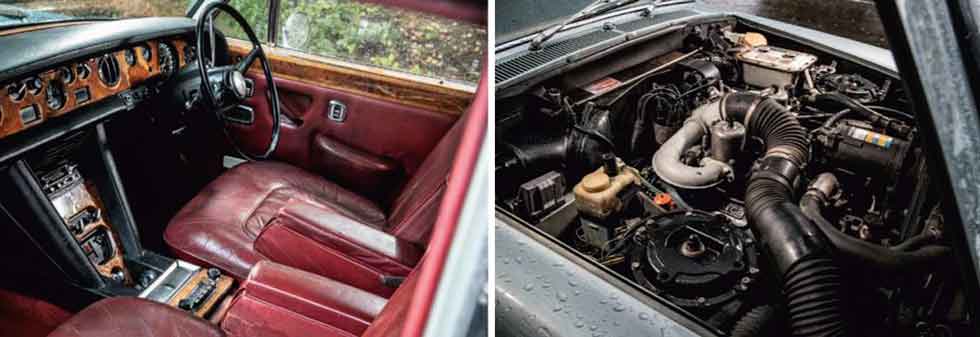
Bentley Eight
The T1 was updated in 1977 to become the T2, then replaced in 1980 by the Mulsanne just as the company was being taken over by Vickers. The Bentley Eight was introduced in 1984 as an entry-level version of the Mulsanne – it was £7500 cheaper so that its selling price was £500 under the psychologically-important £50,000 barrier. From outside the car you could tell you were looking at an Eight because of the wire-mesh grille, which was both cheaper to make and also intended to evoke memories of Bentley’s illustrious racing past. Many commentators were of the opinion that the simpler grille actually suited the car better than the expanse of chrome slats that were fitted to the Mulsanne, and it was later adopted across the Mulsanne range. Early Eights also came with a simpler dashboard and cloth seats, though leather was standard on later models.
A T1 owner behind the wheel of a new Eight would have found plenty that was familiar, but also some departures from previous practice. There’s a little more interior space, and the dashboard layout has been tidied up with a new combination gauge housing fuel level, battery condition, oil temperature and water temperature readouts. But there is still no rev counter, and the quality of the dashboard veneer is noticeably less lavish than it is in the more expensive models. There’s just as much bonnet stretching out ahead of you as in the T-series, but the wings are now flatter and there’s no longer a winged-B mascot at the front.
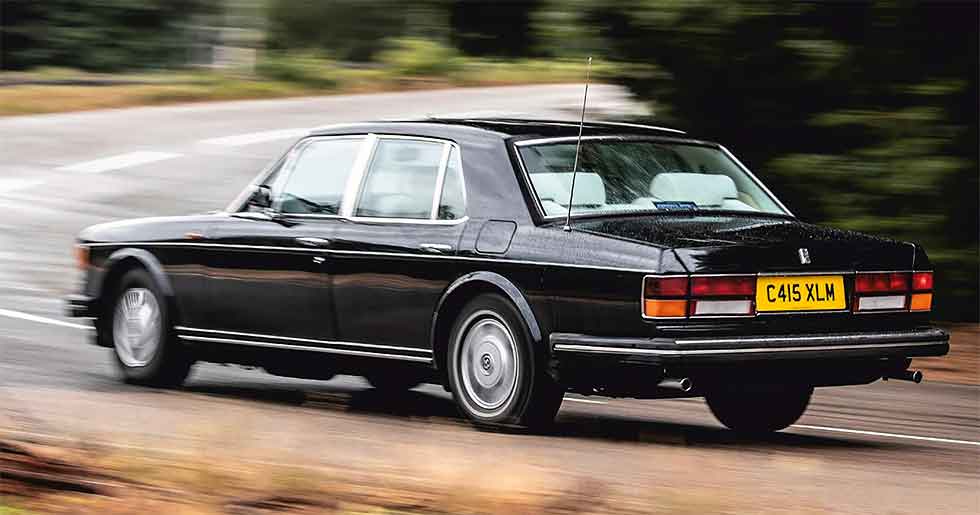
On the move there’s an extra tautness to the ride thanks to stiffer suspension, which Bentley fitted to appeal to younger customers. As a result the Eight tackles a twisty road with more composure than the T1, despite being longer, wider and a good deal heavier. The steering wheel is still a two-spoke item with a narrow rim, but much smaller than before and now controlling rack-and-pinion steering gear which was introduced on the T2 to replace the steering box of the earlier cars. There’s more precision to this steering, but it needs greater effort and there’s still a dearth of feedback relating what’s happening at the front. But it probably suited the tastes of the buyers Bentley was aiming at.
The Eight cruises more quietly than the T-series, but there’s another clue to the clientele Bentley was seeking when you squeeze the throttle down to the Wilton – a distinctly throaty V8 growl emerges, something Crewe would have deemed unseemly only a few years earlier.
Because the Eight is mechanically very similar to the T-series, much of the same advice about buying applies to both. The engines and transmissions are robust but expensive to repair, and if the hydraulic system has leaks or there are signs that the brakes or suspension levelling are not working correctly, an expensive rebuild will be on the cards. Because the interiors were handmade, they can be taken to pieces and reconstructed – at a price.
The steel body rusts, so check the sills and the wheelarches for paint bubbles and filler, and scan the aluminium alloy doors, bonnet and bootlid for dents and creases. Exterior brightwork can rub the paint away on the panel underneath, leading to corrosion.
Eights have more electrical kit than the early T-series, so check everything works because parts can be expensive and repairs are likely to be time-consuming and pricey.
Given the potential costs of restoration, it definitely makes sense to buy the best car you can possibly find, and prices for this model are about as low as Bentleys get. Restoration projects can be found for £2000-£5000, but these cars will inevitably need a lot of money invested to bring them up to a reasonable standard, even if you try to save money by scouring specialist breaker’s yards for parts. Unfortunately, the pile of money you spend is unlikely to be reflected in the rising value of the car.
It’s a much better idea to begin with a sound car, and these can usually be found in the £8000-£10,000 bracket. An Eight in excellent condition, complete with a comprehensive history and finished in a popular colour combination like green with parchment leather, could sell for £15,000. Even at that level you’re still getting an awful lot of car for your money.
‘The stiffer suspension added an extra tautness to the ride in the search for younger customers’
Owning a Bentley Eight
Says Rosabella Hine, ‘Myself, father Nick and brother Rich bought into the Bentley Eight together. It’s beautiful to drive. We haven’t bought it solely as an investment, rather for the enjoyment factor of driving around in the summer in luxury, but it is nice to have something you aren’t going to lose money on and if we do decide to spend money on areas on the Eight we know it will be worthwhile. It had quite a lot of service work on it before we bought it – that was part of the appeal because we could buy and run it without too much initial expenditure. It’s had a quite a busy summer, we’ve used it a lot – it would be a shame to have an Eight and not use it. It’s a big, dominating car with great presence on the road. Everything works – the aircon in particular is super cold! You wouldn’t know you were in an older car – you’ve got everything you’d expect in a modern car such as electric seats and cruise control, with all the pleasure of driving a Bentley.’
TECHNICAL DATA FILE SPECIFICATIONS Bentley Eight
Engine 6750cc V8, 16-valve, Bosch engine management
Max Power 225bhp @ 4000rpm approx;
Max Torque 300lb ft @ 2000rpm approx;
Transmission Three-speed automatic, rear-wheel drive,
Suspension Front: independent, double wishbones, coil springs, anti-roll bar. Rear: independent, semi-trailing arms, coil springs, anti-roll bar, hydraulic self-levelling
Steering Rack and pinion, power-assisted
Brakes Discs front and rear, servo-assisted, anti-lock
Weight 2245kg approx (4949lb)
Performance Top speed: 119mph; 0-60mph: 10sec
Classic Cars Price Guide £5500-£12,500

Bentley Mulsanne Turbo R
Bentley turbocharged the Mulsanne in 1982, then in 1985 it introduced the Bentley Mulsanne Turbo R. The R was for roadholding, and the emphasis on grip led by new engineering director Mike Dunn brought wider tyres on alloy wheels, uprated dampers and new anti-roll bars with double the stiffness at the front and 60% more at the back. Together with better location for the rear suspension crossmember, all this detail work reduced camber changes in cornering, keeping the wheels more upright and giving the bigger tyres more of a chance to grip the asphalt.
It’s too big and too heavy to ever be a sports car, but the Turbo R is more agile and inspires greater confidence than the earlier cars. Later examples like this one had a system called Automatic Ride Control with computer-controlled adaptive dampers that altered their settings automatically in a hundredth of a second, and the result is a fine combination of pliant ride when cruising and control when pressing on. The firmest setting was automatically applied at rest to keep the body level when accelerating from a standstill.
A Sport button inset into the gear lever stiffens up the suspension and also changes the shift points in the automatic transmission, now a more modern four-speed unit. The lever itself has moved from the old-fashioned position on the steering column to the centre console, and there’s plenty more evidence in the cabin of new technology and new thinking. The steering wheel, for instance, is now a leather-bound four-spoke item with a tactile, sculpted rim and its oversized boss houses an airbag. The Turbo R also now has sports seats with subtle side bolsters to provide some lateral location as well as supreme comfort. Outside there is a bigger front air dam, and the rectangular headlamps have been replaced by two pairs of big circular lights.
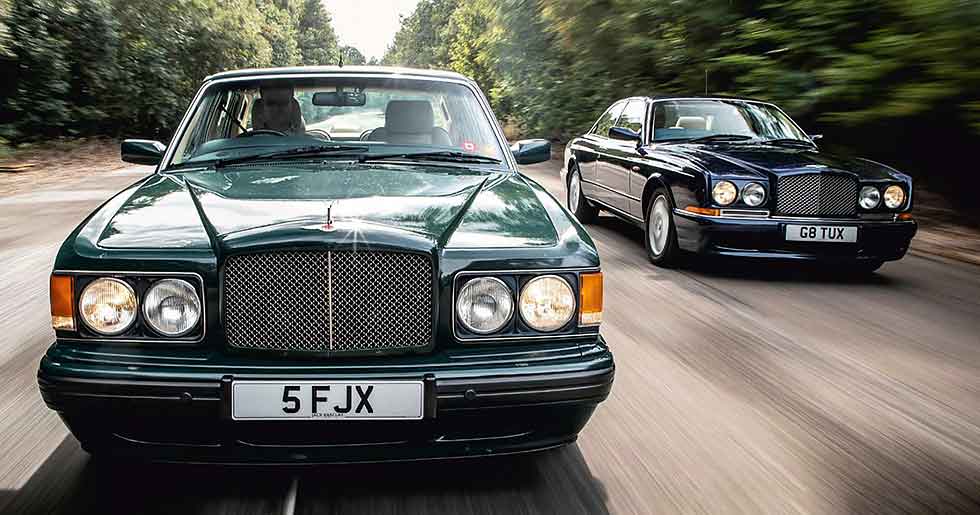
More advances were made under the bonnet. Early Turbo Rs carried over the Solex-carburettored engine from the Mulsanne Turbo, with around 300bhp. In 1986 the engine received fuel injection controlled by a Bosch Motronic engine management system, which was upgraded in 1995 to a Zytek system which provided more power and better economy.
The danger zone on the rev counter is still between 4500rpm and 5000rpm, as it was on the S3 Flying Spur. Plant your right foot on the floor and the ZF gearbox will kick down enthusiastically, and the awesome mid-range thrust keeps on going right up to the red line. Overtaking in the Turbo R is an epic event – you’re constantly aware of a battle between the immense force of the turbo V8 and the mass of steel, hide and timber it’s attempting to propel towards the horizon.
Even in turbocharged form the engine is lightly stressed and capable of huge mileages, provided it is well maintained with oil changes every 6000 miles. The transmissions are equally robust. As with the T1 and Eight, any faults with the complex brake and suspension hydraulics can lead to a substantial repair bill, so it’s important to check for leaks, listen for knocking noises when braking, and watch out for cars where the ride is hard or the rear end fails to rise to the correct level when the car is started.
The Automatic Ride Control on later cars is generally reliable, but if repair is needed costs are high – the ECU is £1600 and a new front damper is £1200, though reconditioned units are available for much less. The underside of the bodyshell was galvanised, so rust should be less of a worry.
The Turbo R was in production for 13 years and there were several variants. The rare 1995 Turbo S had a bigger turbo and Bosch Motronic engine management giving about 385bhp, and there was a Sport limited edition for some markets with different wheels and carbonfibre interior trim. A long-wheelbase RL, available since 1985, took over completely in 1996. In 1998, the last year of production, there were 252 Turbo RT models with Zytek engine management and 400bhp. In concours condition these cars can fetch £40,000 or more, but there are excellent Turbo Rs to be found for £15,000-£20,000. Project cars occasionally come up for £4000 but you’d be brave to take one on.
‘Overtaking in the Turbo R is an epic event – you’re constantly aware of the V8 battling the mass of steel, hide and timber’
Owning a Bentley Turbo R
Says Turbo R owner Robert Shaw, ‘I’ve owned this car for nearly five years now. I think they’re really great cars which are really under appreciated by the market. Even today they are amazing value.
‘The build quality is incredible, the engineering awesome and if properly taken care of will literally last a lifetime. Getting the car regularly serviced is very important, and spending what needs to be spent at the time – for example rubber components get hard and perish. All parts are available and reassuringly expensive! The cost of ownership is the servicing – there is no depreciation. ‘There is no better place to be, cruising along only using 1500-1800rpm – the engine is not stressed at all. You’re floating along in this big lump of metal cosseted by the wood and leather but safe in the knowledge that there’s so much power just waiting under your right foot, if needed. However far you travel, you get out feeling great.’
TECHNICAL DATA FILE SPECIFICATIONS Bentley Turbo R
Engine 6750cc V8, 16-valve, Zytek engine management, twin turbo
Max Power 320bhp @ 4200rpm;
Max Torque 455lb ft @ 2400rpm;
Transmission Four-speed automatic, rear-wheel drive,
Suspension Front: independent, double wishbones, coil springs, anti-roll bar. Rear: independent, semi-trailing arms, coil springs, anti-roll bar, hydraulic self-levelling.
Steering Rack and pinion, power-assisted
Brakes Discs front and rear, servo-assisted, antilock
Weight 2410kg (5313lb)
Performance Top speed: 137mph; 0-60mph: 6.7sec
Classic Cars Price Guide £6500-£16,500
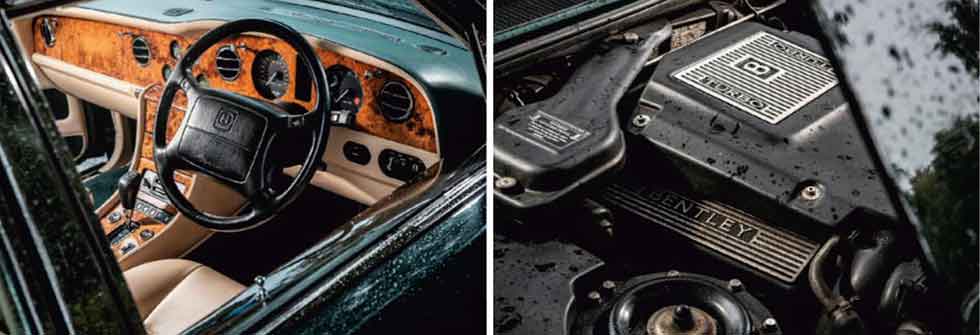
Bentley Continental R
The Bentley Continental R was the marque’s most individual model in years, and the first since the S3 Continental to have an individual body style not paralleled in the Rolls-Royce range. It was an epic exercise in excess – an extravagant two-door grand tourer with a £175,000 price tag, making it the most expensive production car in the world at launch in 1992. It had more power than the Turbo R on which it was based and was even longer than the saloon. Somehow the styling, a team effort between consultants John Heffernan and Ken Greenley – fresh from designing Aston Martin’s Virage – and Bentley’s design team led by Graham Hull, disguised its immense length. The Conti R also introduced features alien to Bentley’s traditional design values, like doors that cut into the roof and box wheelarches that hinted at a Lancia Delta Integrale, though in a more elegant and elongated style.
Despite the Conti R’s length, the big door opens onto a surprisingly snug cabin. I’m average height, but need the electric seat pushed almost to the back of its travel leaving only just enough legroom in the back for small children; headroom is in short supply front and rear too. But never mind the space, look at the quality. There’s soft cream and blue leather all around the cabin, and virtually everything that isn’t covered in hide is faced in rich walnut, with a mixture of bright metal and matt black minor controls. It’s an interesting aesthetic, but one that probably betrays the clash between the bespoke feel Bentley was aiming for and the necessity to pick some of the switchgear from existing parts bins. The transmission selector is in a more modern position on the centre console that Bentley adopted in the Nineties, and in the Conti R the console extends upwards into an imposing centre stack housing a collection of gauges. It’s a spectacular interior, as befits a car that cost all but £200,000 to buy in the early 2000s, about £25,000 more than a Ferrari 456M.
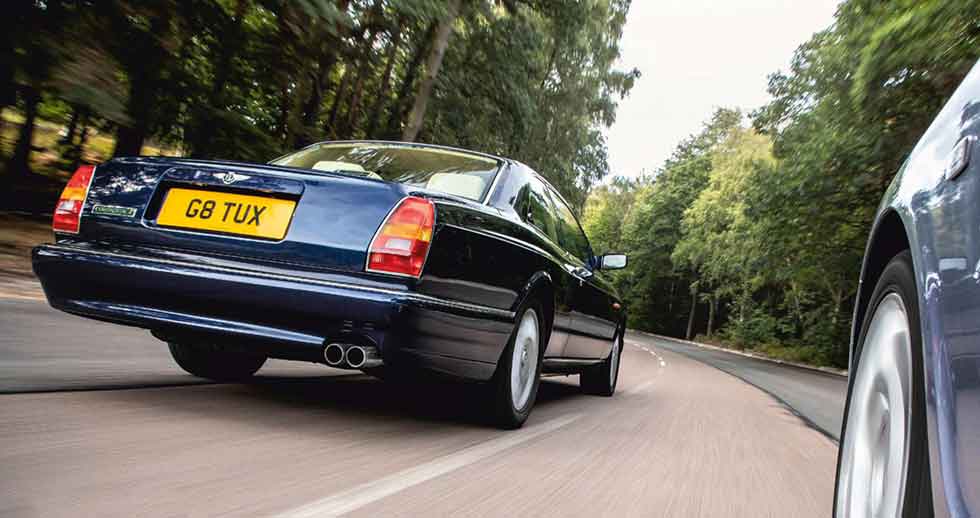
You’re always aware of the Conti R’s sheer size when manoeuvring, and reversing is a challenge because you can’t see any of the tail out of the rear window – and this car is a generation too old to be fitted with parking sensors, so you’re on your own. But out on the open road the Conti R seems to shrink around you, as good GT cars often do. It’s easy to see out, and the raised edges of the front wings make placing the nose accurately on the road a simple matter. It’s easy to steer, with enough resistance in the rim to inspire confidence but not so much that handling the big Bentley becomes an effort. Tight corners produce a good deal of roll, but that’s a fair trade for a ride that’s compliant enough to underline the Conti R’s continent-crushing credentials.
Squeeze the long-travel accelerator pedal and the nose lifts in response to the torque of the turbocharged V8. Performance is brisk rather than breathtaking because even this later-spec 385bhp engine struggles against a kerb weight approaching two and half tonnes, but the way such a vast machine can gather speed and maintain such silence and decorum is little short of remarkable. Big disc brakes with twin calipers up front make light work of shedding speed and feel tireless.
Because the Continental R shares its engine and running gear with the Turbo R, much of the same buying advice applies. But there’s a blemish on the otherwise reliable record of the 6.75-litre engine that affects some of the Contis – cars built from 1998 on suffered from cylinder head gasket troubles and it’s wise to budget for a £3000 replacement. The revised cars built between 1996 and 2003 adopted the air-water intake charge cooler first seen on the limited-edition Conti S together with F1-derived Zytek engine management, and these are the most fancied examples.
The Conti R’s colossal depreciation seems to be levelling out. Around 1500 were made but only a third of those were right-hand-drive UK cars, so supply isn’t limitless. Good ones can be found for around £40,000, and they’re only likely to head upwards over time. The short-wheelbase Continental T, rare Conti S, sliding-roof Sedanca Coupé and convertible Azure are all more expensive to buy than the Conti R they were derived from but if anything it’s the original that is the most elegant and the best all-rounder.
Owning a Bentley Continental R
Says Continental R owner Tony Towers, ‘I’d wanted one since 1993, when I saw a bright red one go through the middle of Cheltenham, and it always stayed in the back of my mind. Mine was a good car with a proper history but there are certain things you budget for, like the hydraulic service every 60,000 miles which is £2000, or the head gaskets at £3000. Tyres for the 18-inch wheels are expensive. There’s no choice other than Pirelli P Zeros – the cheapest I’ve got them is £400 a corner, though they will last 20,000 miles. A service at an independent is only a few hundred pounds because it’s routine stuff. There aren’t many big GTs that are not eye-wateringly expensive, and not delicate. They’re very tough.
The Conti has been my daily driver for the six years I’ve owned it – now and then I have to go out with a toolkit or a chainsaw, and I can do it in the Bentley. It couldn’t be loved more – it’s probably the best-loved Conti in the country.’
TECHNICAL DATA FILE SPECIFICATIONS Bentley Continental R
Engine 6750cc V8, 16-valve, Zytek engine management, twinturbo
Power and 385bhp @ 4000rpm;
Max torque 553lb ft @ 2000rpm;
Transmission Four-speed automatic, rear-wheel drive,
Suspension Front: independent, double wishbones, coil springs, anti-roll bar. Rear: independent, semi-trailing arms, coil springs, antiroll bar, hydraulic self-levelling.
Steering Rack and pinion, power-assisted
Brakes Discs front and rear, servo-assisted, anti-lock
Weight 2402kg approx (5296lb)
Performance Top speed: 151mph; 0-60mph: 6.1sec
Classic Cars Price Guide £20,000-£40,000
‘The way such a vast machine can gather speed and maintain such silence and decorum is little short of remarkable’
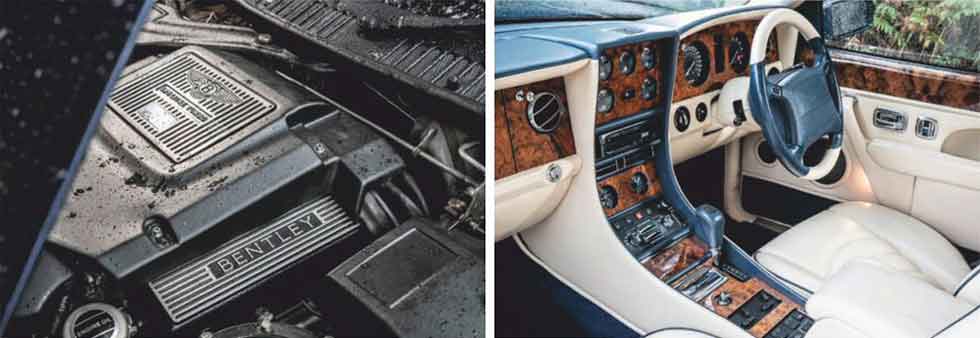
Bentley Continental GT
The Continental name continued on the Continental GT, a very different machine reflecting different times and new ownership. Vickers sold Rolls-Royce and Bentley to Volkswagen in 1998 but the name was still owned by the aero engine company, Rolls- Royce plc. BMW, which already had a relationship with the aero engine company through a jet-engine joint venture, bought the rights to use the name on motor cars. Volkswagen ended production of the old-school Rolls-Royce cars in 2002 to concentrate on the Bentley brand, while BMW established a new Rolls-Royce production facility at Goodwood.
The Conti GT unveiled in 2003 was all new, and feels it. It’s far smaller than the previous generation of cars, and I sit low down in a cocoon of a cockpit. In this Mulliner-spec car I’m enveloped by a heavily bolstered sports seats and surrounded by jewels of detail like the diamond-quilt upholstery, alloy pedals and machined metal grip of the gear lever. The starter button, also down on the centre console, spins the engine with an urgent whirr and as the motor erupts into life you’re left in no doubt that this car is unlike anything Bentley had ever built before.

Under the bonnet is a twin-turbo, 6.0-litre version of Volkswagen’s W12 engine. Volkswagen pioneered the modern narrow-angle V engine with the VR6 in 1991, and the all-alloy W12 is essentially two of these mounted on a common crankshaft at a 72-degree angle. The resulting engine was broad but not very long, making it a convenient shape to package under a smaller bonnet than Bentleys of yore. It sounds like nothing else – bolder and bassier than a V6, throatier than a V12, with an off-beat burble that’s oddly addictive. With 553bhp delivered through a ZF six-speed auto transmission to a four-wheel-drive system with a Torsen centre differential, there’s no wheelspin as the Conti GT sprints away from a standing start to hit 60mph in less than five seconds. The Speed and Supersport editions had even more power and delivered supercar-rivalling acceleration times.
The Conti GT corners hard and flat, with more feel through the steering than previous Bentleys and far greater agility. There’s more road noise in this car than in its forebears, particularly on abrasive road surfaces, but also more of a feeling that this is a properly sorted tool for serious driving. Yet it cruises quietly enough not to interfere with casual conversations, and you could cover hundreds of miles without feeling fatigued on arrival. It’s the most recent design of our group and probably had the greatest resources lavished on its development, so inevitably it feels like the most complete package. What’s more of a surprise is that it’s also brimming with character and panache all of its own.
The Continental GT has its own set of strengths and weaknesses as a classic car buy. The vacuum pipes at the back of the engine bay above the gearbox can split where plastic pipes meet metal connectors, and pre-2005 cars suffer from starter problems. Both of these issues need the engine out to cure, at a cost of at least £4500. The W12 itself is largely trouble-free, though bad connections can cause electrical problems, and if you’re unlucky enough to blow a head gasket you’re looking at a £15,000 repair bill. Radiators can fail, and the front bumper has to come off to replace it, leading to more hefty outlay. Air suspension units can fail and will cost around £2000 a corner to fix at a specialist, though DIY is possible for a competent mechanic. Tyre pressure sensors need to be replaced every five years, at a cost of around £250 a corner. Spirited driving can wear the brakes rapidly, and replacing the front discs and pads will cost £1000. On the plus side, the interiors wear well and the comprehensive equipment tends not to give too much trouble, though it’s important to check everything works as it should. GTs can be covered by Bentley’s Pre-Owned programme, which includes a new-car-like warranty. High-mileage cars dip below £20,000, but there are plenty of lower-mileage cars with good histories between £20,000 and £30,000, which will surely rise as supplies dwindle; the high-spec Mulliner and 621bhp Supersports models are particularly sought after. But more than 35,000 Conti GTs were built before the second generation arrived in 2011, so there are still plenty to choose from.
‘There’s more road noise in this car than in its forebears, but also more of a feeling that it’s a properly sorted driving tool’
Owning a Bentley Continental GT
Says Continental GT owner Chris Faulkner, ‘I thought if I don’t get one of these now I’d be too old to drive it or they’ll ban petrol or something – now was the time to do it. I’ve had it two and half years. It was affordable – a gorgeous car for very little money – about £30k. I didn’t want a big old bus. It has style – the shape of it is like the S3. I was looking for the Mulliner, for an extra twist. ‘There are lots of foibles with Conti GTs. The air suspension went on one corner but I managed to fix it myself for £400 using an Audi part – there are quite a few bits with Audi or Volkswagen logos on them. It will be an iconic car, if it’s not already. It turns heads and it’s fun on the road. I took it to Le Mans a couple of years ago and it rained – it sank lower and lower in the muddy camping field but then I started it and it came out on tickover. We’ve just done the North Coast 500 in it and we had a whale of a time.’
TECHNICAL DATA FILE SPECIFICATIONS Bentley Continental GT
Engine 5998cc W12, 48-valve, multipoint indirect fuel injection, twin turbo
Max Power 553bhp @ 6100rpm;
Max torque 479lb ft @ 1600-6100rpm;
Transmission Six-speed automatic, four-wheel drive,
Suspension Front: independent, double wishbones, air springs, anti-roll bar. Rear: independent, multi-link, air springs, anti-roll bar.
Steering Rack and pinion, power-assisted
Brakes Discs front and rear, servo-assisted, anti-lock
Weight 2350kg (5181lb)
Performance Top speed: 198mph; 0-60mph: 4.8sec
Classic Cars Price Guide £19,000-£42,000
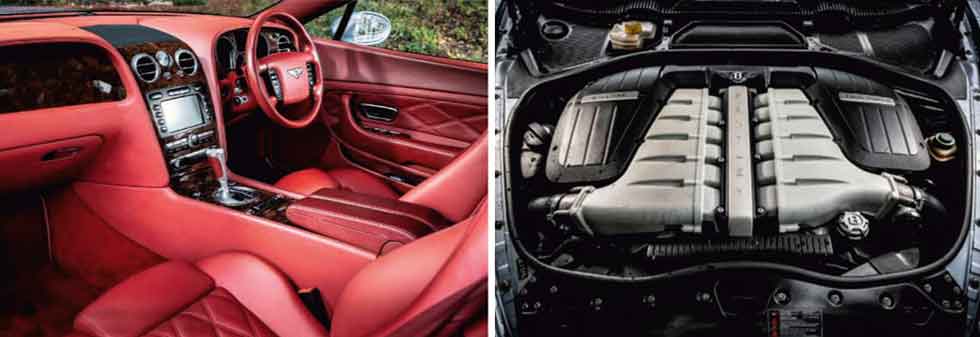
Verdict
Choosing between our six bargain Bentleys is made easier by their differing values. An S3 Flying Spur is a fine machine with a wonderful period ambience and an upper-class demeanour the others cannot match, and while it may never reach the values of the two-door Contis it will surely appreciate over time. If you have a six-figure sum available and a hankering for a Sixties Bentley, there will never be a better time to take the plunge. But if you’re looking to spend less, the rest of our group provides some attractive options.
The most recent of them, the Continental GT, offers all-weather practicality, impressive outright speed and few ownership niggles for around £30,000. A little more buys a Conti R which is a generation older, and adds a grand sense of occasion to every trip with its hand-crafted interior and the character of the big V8. Much the same is true of the imperious Turbo R, which has tidy handling and effortless speed from around £20,000 for a good one. For half that you can get a good Eight or T1. The choice hinges on whether you prefer the T1’s old-money sophistication or the Eight’s more precise road manners and square-shouldered looks. For me it’s the T1 that offers a more compelling package, mixing a little of the S3’s classic charm with cossetting modern suspension. It’s relatively rare, too, though the tens of thousands of its Rolls- Royce sibling means there’s plenty of specialist support.
Despite a value staircase of bewinged beasts topping out at £250k, it’s the two models available from around £10k that Andrew is most bewitched by.

Thanks to: Harry Waddingham of the Bentley Drivers Club (bdcl.org); Giles Crickmay at Frank Dale and Stepsons (frankdale.com); Lance McCormack at Romance of Rust (romanceofrust.com); Mike Sayer at Bentley Motors (bentleymotors.com)
Dirk Van Braeckel
There’s a thin pen-line between celebrating the past and creating a retro pastiche of it – just ask the man who steered Bentley into a new century via Continental GT.
Belgian-born designer Dirk Van Braeckel had experience at Ford, Audi and Skoda before moving to Bentley as design director in 1999, where he was soon hard at work on what would become the Continental GT. ‘Designing the Continental GT was quite a quick process,’ he remembers. ‘Starting the project in August 1999 we had a decision on the exterior by December that year!’ Two models were produced as the design was refined, the aim being to blend understatement, sportiness and heritage. ‘I particularly wanted to avoid the retro design trap, but inspiration came from the brand history and the idea of Grand Touring in the true sense. Power, space for four adults and their luggage, enabling them to travel over the continent in great style, pace and comfort.’
The exterior design was intended to be reserved, and yet still hint at the car’s potential. ‘A Bentley has substance, a Rugby player in a pin-stripe suit. It was not to be in-your-face, but cool.’ Inspiration came from one of Bentley’s greatest cars, the R-type Continental of 1952-1955. ‘I wanted to create a true Bentley Grand Tourer,’ he says. ‘The front haunch line and the rear haunches were typical of the muscular Bentley look and also helped to reestablish the marque as a sporting brand. Modern proportions and surfacing did the rest. The symmetrical winged dashboard created an equal feeling for driver and co-driver. When our Bentley colleagues at the time saw the GT they thought it looked amazing.’ Key to Bentley’s design is its historic links to motor sport and Le Mans, van Braeckel says. ‘All that happened in the first 11 years of the brand is still inspiring today and of course the cars that resulted kept the brand alive all those years.
‘The design of the face was key. Essential were the four round headlights set in a “coachbuilt” front wing, along with a typical Bentley matrix grille and radiator shell. Then it required a wheel-oriented body design with a short front overhang, long bonnet and sporty cabin with a generous rear overhang. Also integrated surfaces with no unnecessary shut lines.’ Inside, full leather and fine detailing are essential. ‘Real materials of leather, metal and wood that looks, and is, hand-made.’
Of the Bentleys he was involved in, he’s particularly proud of the the original Conti GT Supersports – ‘because it was the best looking Conti’ – the ‘beautiful and mean’ Brooklands and the Mulsanne for its timeless style. As well as the R-type Continental he cites Woolf Barnato’s so-called Blue Train car, a Speed Six with one-off coupé bodywork by Gurney Nutting, as a personal favourite. ‘I love it,’ he says, ‘because it is truly exceptional.’ Casting his eye over our bargain Bentley group, van Braeckel is particularly taken with the Flying Spur. ‘It’s still such a fantastic car,’ he says. ‘I remember seeing one parked in London W1 and it looked so rich! The quality of those surfaces were also an inspiration. I also like the Conti R, which was actually still in production when I designed the GT.’
Van Braeckel moved on to a senior design role with Audi, but clearly retains a passion for Bentley. ‘Being driven in Paris, on the Champs Élysée and around the Arc the Triomphe, in a Thirties Blower was amazing,’ he says. ‘Only driving a Brooklands through Scotland gave me a similar feeling. Awesome.’
‘All that happened in the first 11 years of the Bentley brand is still inspiring today’
These sketches by van Braeckel’s understudy Raul Pires show variations on a theme dominated by a matrix grille, round headlights, big wheels, pronounced shoulders and a deliciously rakish profile. Note the early, Audi-like grille design concept two below.
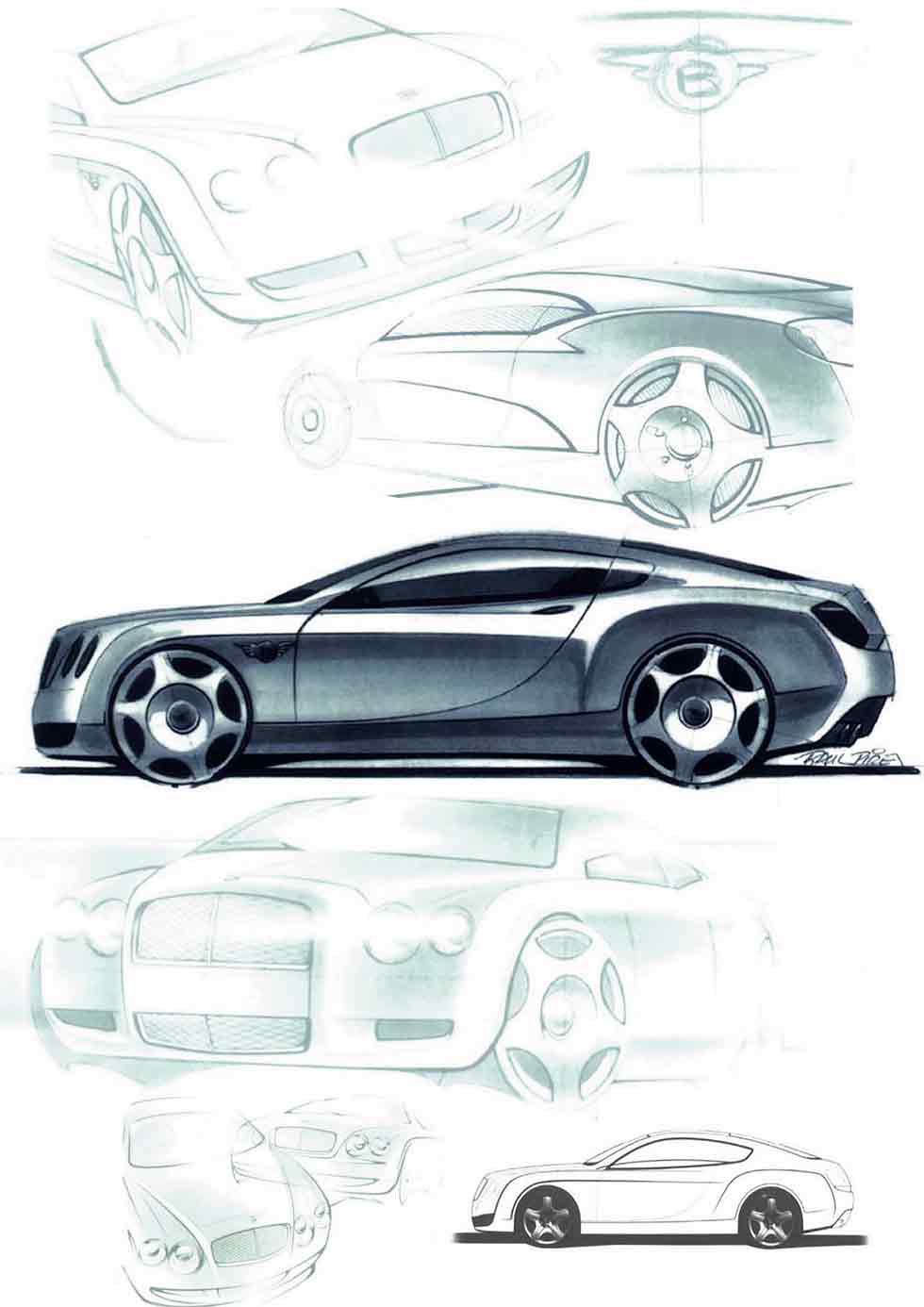
Bentley’s Racing Pedigree
Founded in 1919, Bentley won its first race in 1921. Development driver Frank Clement won the Whitsun Junior Sprint Handicap at Brooklands in EXP2, the second prototype 3 Litre made. Today EXP2 is the oldest surviving Bentley, and is one of the jewels in Bentley’s heritage car collection.
More victories followed for 3 Litre Bentleys in private hands and in 1923 one of those drivers, John Duff, entered his car in the first Le Mans 24-hour race. WO Bentley was dead against the idea, saying that 24 hours at racing speed was more than any car was designed to endure – but he agreed to offer arm’s-length works support. Works driver Clement acted as co-driver, and the Bentley finished fourth and set the fastest lap of the race. In 1924 Duff and Clement returned as a full works entry and won the race outright. Despite Bentley’s reputation for solid, reliable cars the five works entries at Le Mans over the next two years all retired with mechanical problems. Then in 1927 a crash eliminated two Bentleys, one of them the new 4½ Litre, and almost claimed the ‘Old Number Seven’ 3 Litre of Sammy Davis. Despite damage sustained hitting the wreckage of the other cars, Davis and Dudley Benjafield raced on through the night, with one working headlamp supplemented by a torch strapped to the windscreen, and won the race ahead of a gaggle of French cars.
Bentley chairman Woolf Barnato shared the winning 4½ Litre with Bernard Rubin in 1928, and Barnato won again in 1929 in a Speed Six alongside ‘Tim’ Birkin, ahead of a trio of 4½ Litres. Barnato’s third Le Mans win, and Bentley’s fifth, came in 1930 when Speed Sixes finished first and second after Birkin’s supercharged 4½s failed– though they did set an early pace that was fast enough to cause the Mercedes of Caracciola to expire. But then the company ran out of money, was taken over by Rolls- Royce, and there were no more works racing entries that century.
The revival came in 2001. Bentley was now owned by the Volkswagen Group, and stablemate Audi provided the basis for a new closed-roof Le Mans car with a 3.6-litre V8 petrol engine. Like Audi’s racing prototypes the two Bentley EXP Speed 8s were designed and built by Racing Technology Norfolk in Hingham. In the race one car retired after a fire, but the other finished third behind two Audi R8s. In 2002 a 4.0-litre engine was fitted to a single car which finished fourth. Two revised cars went to Le Mans in 2003 and this time Bentley dominated the race, with Tom Kristensen, Dindo Capello and Guy Smith winning from the sister car of Mark Blundell, David Brabham and Johnny Herbert.
Mission accomplished, Bentley retired from top-level Le Mans racing. But in 2012 it was back with a GT3-class Continental GT concept, and unveiled the definitive Conti GT3 at the 2013 Goodwood Festival of Speed. Unlike the four-wheel-drive road car the GT3 car is rear-drive only, with a six-speed sequential gearbox and stripped-out interior. Entered into the 2014 Blancpain Endurance Series, it recorded its first win at the Silverstone round in May. In 2017 Bentley won the team championship after a win in France and second place in the Spa 24-hours.
The second-generation GT3 appeared in 2018, finishing second at the Paul Ricard 1000km and running strongly in the Spa 24-hours until both cars were forced to retire.
‘They raced on through the night with a torch strapped to the windscreen’
